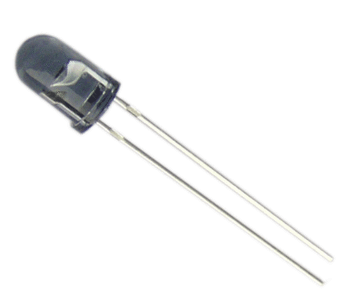
It is actually very simple you know...it' all based on two primary things:
- LED won't be on at all times, so maybe we can get a little over that max current reating on the datasheet
&
- LEDs emit a cone of light, if we make it so that they emit a cylinder instead, the range gain will be enormous.
Now, I am currently driving the LED in my laser tag tagger (or "weapon") at 1A/5V without any problems. I am using 50% duty cycle modulating it at 38KHZ and i'm using the sony protocol. Even if i fire (= send a command of 16 bits + header) continuously with the tagger th LED still does a fine job. There are even guys that run it with no resistor at all, check this out:

and as far as i am told it still works great. ( a note on the above circuit: you don't actually need 2 transistors, but to make it clearer i'll explain how the above works: for outdoor play this laser tagger activates both mosfets so effective resistance is actually zero, not counting Rds-on and other stuff of course. When playing indoor the mosfet on the right deactivates so that IR bouncing off walls becomes less of an issue)
But 1A alone won't do much really. The "big" secret is actually making the light into a cone, and to achieve this the simplest method is to use a double-convex (magnifier) or plano convex (both will do) lens to focus it down.

The above picture shows where to place the lens. Basically each lens will have its focal lenght and so you'll need to set the LED at the appropriate distance to maximize the effectiveness of this setup. You also have to consider the angle of intenisty of the LED which is usually written in the datasheets. The most common IR LED between laser tag DIYers is the TSAL6100 which has an angle of half intensity = 10° meaning that the total angle will be 20° (see above picture). Once you know all these things you just set em up and you're good to go.
A tip for focusing it correctly: only use theory to get an approximate positioning of the lens/LED, trial and error works way better for some reasons ( for example: focal lenghts for visible light might be different from FL for IR). So..try it out! To do this you just need some patience and a camera, but not all will do. The most appropriate ones are the ones with "night mode" or "night vision" modes, with which you can clearly see when the beam gets focused correctly.
That's all...I might have forgotten something, but i'll update it soon if that's the case!
UPDATE!
What if i want long range transmission, but still want to have a cone of light at destination?

This is the solution! Basically you could have a beacon which is perfectly aligned with the cylindrical beam, which is connected to an MCU that reproduces the exact same code and feeds it to an unfocused IR LED so you'll be sure to communicate with your bot even if its sensor is not perfectly aligned with the "master transmitter".

